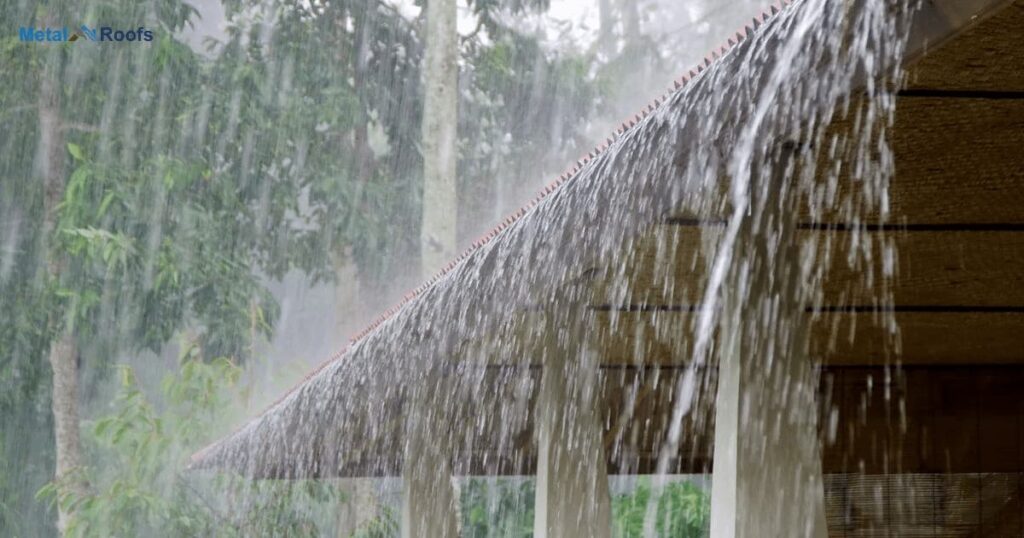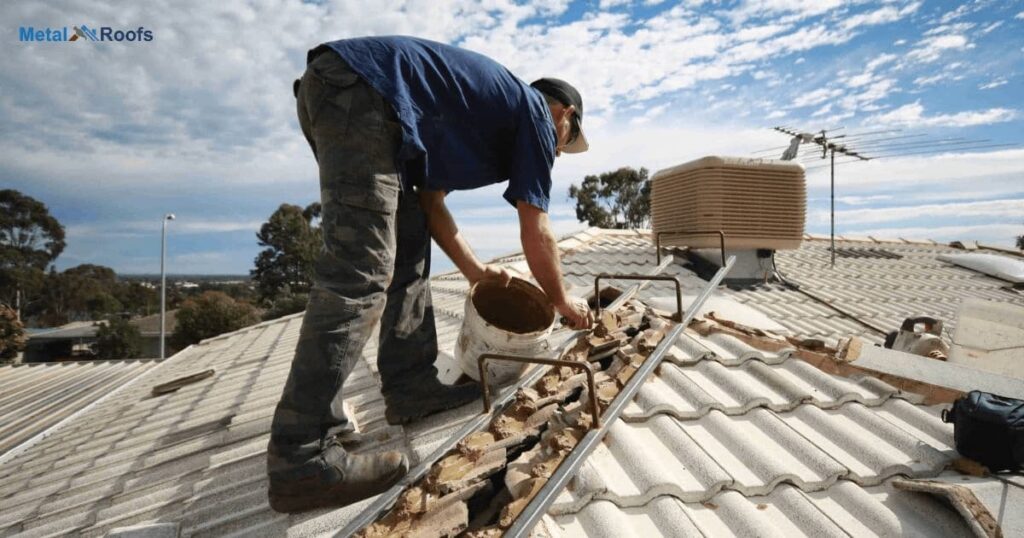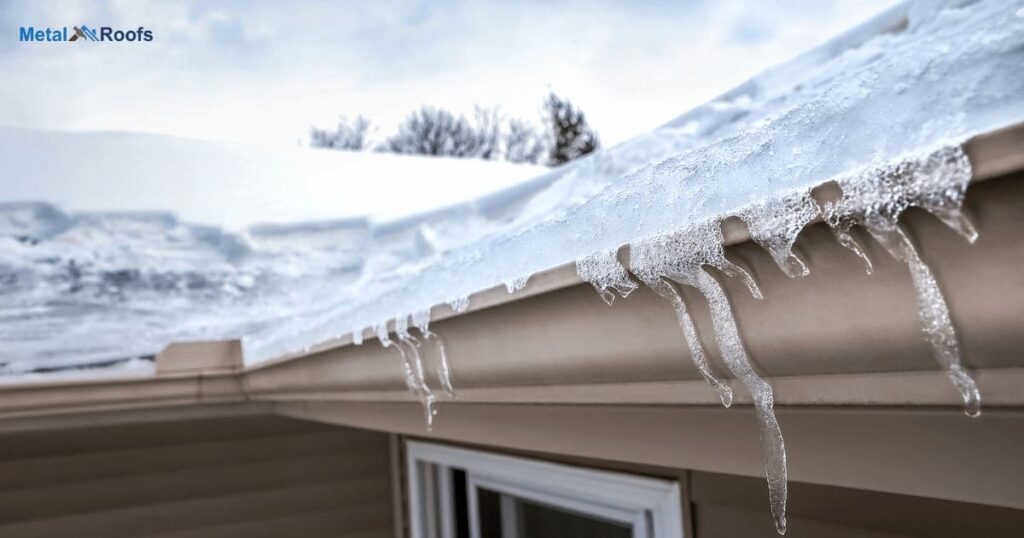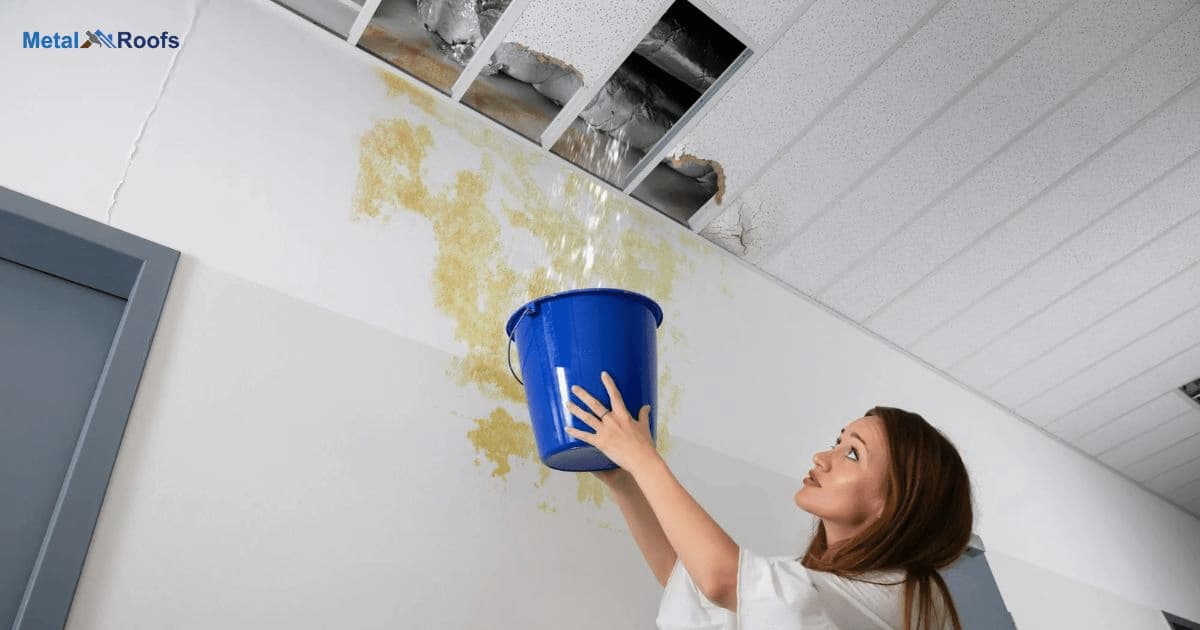Leak causes water to enter home. Metal roof develops small holes. Water drips through these holes. Leak damages roof deck and ceiling. Fixing leak prevents more damage. Roofer locates and seals leak spot. Proper repairs restore roof’s life.
Drip, drip, drip – a leak persists. how to find a leak in a metal roof? Listen for water sounds indoors. Inspect roof for discolored areas. Use a hose to simulate rain. Locate the entry point precisely. Prepare to fix that stubborn leak.
Locating the leak’s origin is crucial to prevent structural damage. Check for water stains on ceilings and walls, and inspect the attic for dampness. Trace the source, such as damaged colonial slate shingles Certainteed, and seal to stop further water entry.
Key Takeaways
- Visual inspection for damage
- Check flashings and seals
- Conduct water test from lowest to highest point
- Inspect interior for water stains or dampness
- Use smoke test to detect leaks
- Consider thermal imaging for moisture detection
- Consult professional roofing contractor if needed
Roof Leaks In Heavy Rain
When heavy rain hits, checking your roof for leaks is crucial. Start by visually inspecting for any visible damage, like missing panels or rust spots. Check the flashings and seals around vents and chimneys for gaps or cracks. If you suspect a leak, conduct a water test by spraying the roof and checking for interior signs of water ingress.
Look for water stains or damp spots on the ceiling or walls. Consider using a smoke test to pinpoint the leak’s location, sealing off the interior space and introducing smoke to observe its escape. If necessary, consult a professional roofing contractor for expert diagnosis and repair.
Sealant For Metal Roof
| Type of Sealant | Features |
| Silicone | Weather-resistant, flexible |
| Polyurethane | Durable, excellent adhesion |
| Butyl Rubber | Easy to apply, waterproof |
| Acrylic | Cost-effective, UV resistant |
When dealing with a metal roof, using the right sealant is crucial. Start by inspecting the roof visually for any damage. Look for cracks or gaps in the sealant around roof penetrations like vents and chimneys.
If you find any, clean the area thoroughly before applying the sealant. Make sure to choose a high-quality sealant that is compatible with metal surfaces. Apply the sealant evenly and generously to ensure a watertight seal.
After application, monitor the sealed areas regularly for any signs of wear or damage. If needed, reapply the sealant to maintain protection against leaks. Consulting a professional roofer can help ensure the right sealant is chosen and applied correctly for optimal results.
Metal Roof Leaks In Heavy Rain

During heavy rain, metal roofs can develop leaks if damaged. Start by visually inspecting for missing panels or rust spots. Check flashings around vents and chimneys for gaps. Use a hose to simulate rain while someone inspects indoors for leaks.
Look for water stains on ceilings or walls. If necessary, use a smoke test to pinpoint leaks. Consider thermal imaging for detecting moisture. Consult a professional roofer for complex issues.
Metal Roof Leaking At Overlap
If your metal roof is leaking at the overlap, start with a visual check. Look for any visible damage like rust spots or gaps. Check the seals and flashings around any roof penetrations like vents or chimneys. If you can’t see the problem, conduct a water test. Use a hose to simulate rain, starting low and working up.
Inspect the inside of the building for signs of water entry. Look for stains or damp spots on the ceiling or walls. Consider using a smoke test to detect leaks if needed. If you’re unsure or dealing with a complex issue, it’s wise to consult a professional roofing contractor.
Metal Roof Leak Repair Cost
When it comes to fixing a leak in a metal roof, costs can vary. The repair expenses depend on factors like the extent of damage and the roofing professional’s fees. For minor issues, patching holes or resealing seams might suffice, keeping costs relatively low. Extensive damage or the need for professional assistance can increase the repair expenses significantly.
Metal roof leak repair costs typically include materials like sealant or replacement panels and labor fees for the roofing contractor. DIY repairs may save money upfront but can lead to additional expenses if not done correctly.
Metal Roof Repair Products

When it comes to fixing metal roofs, there are various products available. These include sealants, coatings, and patches. Sealants are used to fill gaps and cracks, preventing water from seeping through. Coatings provide an extra layer of protection against rust and corrosion, extending the roof’s lifespan.
Patches are handy for repairing small holes or damaged areas in metal panels. They’re often made of durable materials like aluminum or fiberglass. These products are easy to apply and can help maintain the integrity of your metal roof, saving you from costly repairs down the line.
Essential Tips For Maintenance
Maintenance is crucial for keeping things running smoothly and avoiding costly repairs down the line. Here are some essential tips for effective maintenance:
Regular Inspections: Schedule routine inspections to identify any issues early on. This applies to everything from your car to your home appliances.
Create a Maintenance Calendar: Keep track of when maintenance tasks are due for different items or systems. This can be done digitally or with a physical calendar.
Follow Manufacturer Guidelines: Refer to the manufacturer’s recommendations for maintenance intervals and procedures. This ensures you’re taking the right steps to keep your belongings in optimal condition.
Keep Things Clean: Regular cleaning not only keeps items looking good but also prevents the buildup of dirt and grime that can cause damage over time.
Check Fluid Levels: For vehicles and machinery, regularly check and top up fluids such as oil, coolant, and brake fluid.
Inspect for Wear and Tear: Keep an eye out for signs of wear and tear such as frayed wires, leaks, or cracks. Address these issues promptly to prevent further damage.
Lubrication: Many mechanical systems require proper lubrication to function smoothly. Make sure to lubricate moving parts according to manufacturer recommendations.
Test Safety Features: For equipment or appliances with safety features (e.g., smoke detectors, safety valves), test them regularly to ensure they’re functioning correctly.
Replace Filters: Air filters in HVAC systems, vacuum cleaners, and cars need regular replacement to maintain efficiency and air quality.
Keep Records: Maintain a record of maintenance activities performed, including dates and any issues identified. This helps track patterns and ensures nothing falls through the cracks.
Address Issues Promptly: Don’t ignore small problems as they can escalate into larger, more expensive issues. Address them as soon as they arise.
Invest in Professional Maintenance: While DIY maintenance is great for many tasks, some things are best left to professionals. Invest in professional maintenance for complex systems like HVAC, electrical, or plumbing.
Plan for Seasonal Maintenance: Some maintenance tasks are best done at specific times of the year. Plan ahead for seasonal maintenance like checking heating systems before winter or inspecting air conditioning units before summer.
Emergency Preparedness: Have a plan in place for emergencies, such as power outages or equipment failures. Know how to shut off utilities if needed and have emergency contact information readily available.
By following these essential maintenance tips, you can prolong the lifespan of your belongings, prevent costly repairs, and ensure everything runs smoothly.
How Can I Inspect The Roof’s Surface?
To inspect the roof’s surface, start by visually checking for any visible damage like missing panels or rust spots. Next, examine the flashings and seals around roof penetrations for cracks or gaps. After that, conduct a water test by spraying the roof with a hose, starting from the lowest point and moving upwards.
While you do this, have someone check inside for signs of water entering the building. Then, inspect the interior of the building for water stains, drips, or damp spots on the ceiling or walls. Check the attic or crawl space for any signs of water entry, such as wet insulation or wood framing.
Prevent Ice Dams And Moisture Damage

To prevent ice dams and moisture damage on your roof, start by checking for any gaps or cracks in the flashing and seals. Ensure they’re properly sealed to keep water out. Then, inspect the attic for proper insulation and ventilation. Adequate insulation prevents heat from escaping and warming the roof, which can melt snow and create ice dams.
Good ventilation helps regulate temperature and moisture levels, reducing the risk of condensation and mold growth. Consider installing gutter guards to prevent debris buildup, which can contribute to ice dam formation. Addressing these key areas, you can help protect your roof from ice dams and moisture damage, preserving its integrity and prolonging its lifespan.
How Can I Identify Loose Or Missing Fasteners?
To identify loose or missing fasteners on a metal roof, start by visually inspecting the roof for any screws or nails that appear to be loose, protruding, or completely missing. Walk around the perimeter of the roof and carefully examine each panel, paying close attention to areas where panels overlap or where flashing is installed.
Look for any signs of movement or separation between panels, which may indicate loose fasteners. Next, gently tap on the panels with a rubber mallet to listen for any hollow or loose sounds, which could suggest that fasteners underneath are not properly secured.
Check For Cracks And Holes
When checking for cracks and holes in a metal roof, start with a visual inspection. Look closely for any signs of damage, such as small openings or splits in the metal panels. Pay attention to seams and joints where cracks are more likely to occur. If you spot any cracks or holes, mark them for repair.
Next, inspect the areas around roof penetrations, such as vents or chimneys, as these are common locations for cracks to develop. Use a flashlight to examine the underside of the roof for any light shining through, indicating potential holes. Take note of any areas where water could seep through and cause further damage.
Frequently Asked Questions
What Is The Best Way To Seal A Leaking Metal Roof?
Inspect roof. Identify leaks. Patch holes with sealant. Check flashings. Apply sealant generously. Consider metal roof coating. Maintain regularly.
What Is The Most Common Leak On A Metal Roof?
The most common leak on a metal roof is around flashing, where gaps or deteriorating seals can occur. Regular inspection and maintenance can prevent these leaks.
How Do I Pinpoint Where My Roof Is Leaking?
Inspect visually for damage. Check flashings and seals. Conduct water test. Inspect interior. Use smoke or thermal imaging. Consider professional help if needed.
Conclusion
Identifying a leak in a metal roof requires thorough examination. By visually inspecting for visible damage and checking flashings and seals, you can locate potential sources of leaks. Conducting a water test and inspecting the interior for signs of water entry further aids in pinpointing the leak.
Utilizing advanced techniques like smoke tests or thermal imaging can enhance detection accuracy. If the leak remains elusive, seeking assistance from a professional roofing contractor ensures effective resolution and prevents further damage to the building.











